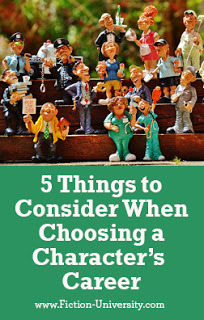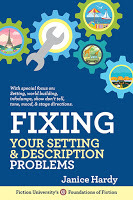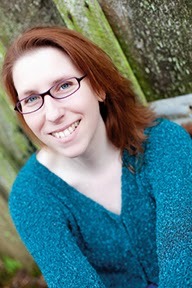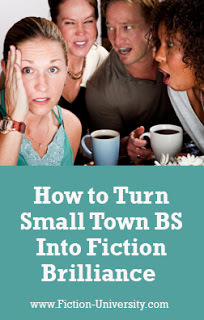Janice Hardy's Blog, page 66
September 4, 2019
Open Up! Writing the Opening Scene
 By Janice Hardy, @Janice_Hardy
By Janice Hardy, @Janice_Hardy I've gotten no writing done this week as I prepped for Hurricane Dorian, so here's a dip into the archives for a popular favorite. Thankfully, Dorian skirted far enough east to only be a nasty storm here where I live, and I'm watching the trees whip around as I write this. To my fellow Floridians and Southeast Coasters...stay safe.
The primary goal of an opening scene is to make readers want to read the next scene.
You’d be surprised how often this is forgotten, because the focus is on establishing the setting, introducing the protagonist, and telling readers all about the cool story waiting for them. These are all important things, but on their own they’re not going to do what an opening scene needs to do—grab readers and keep them reading.
Continue ReadingWritten by Janice Hardy. Fiction-University.com
Published on September 04, 2019 03:39
September 3, 2019
The Budrys Rule: Three Writerly Sins, One of them Cardinal
 By Dario Ciriello
By Dario CirielloPart of The How They Do It Series
JH: Dario Ciriello returns to the lecture hall today with three "rules" writers should never break. And for once, these rules are ones writers really should live by.
As an editor/copyeditor who reads a lot of manuscripts, I see many potentially fine, well-written novels with believable characters, rollicking plots, and crisp dialogue fail because they fell short of what I call The Budrys Rule.
The late Algis Budrys was a famous science fiction author, editor, teacher, and critic. He taught for many years at the Clarion Writers Workshop, and worked as a book editor for Playboy magazine. In his fine little 1994 craft manual, Writing to the Point, Budrys gives one of the clearest and best pieces of advice to authors I’ve ever read, and does it so succinctly it works as a simple mnemonic.
Continue ReadingWritten by Janice Hardy. Fiction-University.com
Published on September 03, 2019 05:03
September 2, 2019
5 Things to Consider When Choosing a Character’s Career
 By Janice Hardy, @Janice_Hardy
By Janice Hardy, @Janice_Hardy Due to story prep for Hurricane Dorian, I'll dipping back a year and pulling form the archives today. Enjoy this look at why a character’s job is a useful tool when developing a novel.
I’ve been working hard on a new book this week, and since it’s a bit outside my normal genre (this one’s a science fiction detective novel), I’ve had to do a few things differently. There are elements to this genre I haven’t had to worry about in previous books.
Most notably, has been how my protagonist’s job affects the rest of the plot. As a private investigator, his job is the plot, and that career choice affects pretty much everything else in the novel.
In one way, this makes developing this novel easier. I have very clear parameters to work in, and a specific character type to flesh out.
In another way, it adds a layer of difficulty. The most obvious and easiest path is also the most overused or even cliched. I don’t want that, even if I might want to play with the tropes and cliches a little (I can never resist this—it’s too much fun).
Continue ReadingWritten by Janice Hardy. Fiction-University.com
Published on September 02, 2019 05:08
August 31, 2019
Real Life Diagnostics: Would You Keep Reading This Middle Grade Science Fiction Story?
 Critique By Maria D'Marco
Critique By Maria D'Marco Real Life Diagnostics is a weekly column that studies a snippet of a work in progress for specific issues. Readers are encouraged to send in work with questions, and we diagnose it on the site. It’s part critique, part example, and designed to help the submitter as well as anyone else having a similar problem.
If you're interested in submitting to Real Life Diagnostics, please check out these guidelines.
Submissions currently in the queue: One
Please Note: As of today, RLD slots are booked through September 7.
This week’s question:
Is this chapter working?
Market/Genre: Middle Grade Science Fiction
On to the diagnosis…
Continue ReadingWritten by Janice Hardy. Fiction-University.com
Published on August 31, 2019 06:05
August 29, 2019
8 Tips on Balancing Work and Writing
 By Evan Ramzipoor @ER_Ramzipoor
By Evan Ramzipoor @ER_Ramzipoor Part of The Writer's Life Series
JH: It's not easy finding the balance between working and writing, but it's something almost every writers faces at some point. Evan Ramzipoor returns to the lecture hall today, with tips on how to find that precious balance
Evan Roxanna Ramzipoor is a writer based in California. She also works as a content marketer, writing about cybercrime and online fraud. She studied political science at UC Berkeley, where she researched underground literature in resistance movements and discovered the forgotten story of Faux Soir. Her writing has been featured in McSweeney's and The Ventriloquists is her first novel. She lives with her partner and a terrier mix named Lada
Website | Goodreads | Facebook | Twitter |
Take it away Evan…
Continue ReadingWritten by Janice Hardy. Fiction-University.com
Published on August 29, 2019 04:03
August 28, 2019
Leave a Message at the Tone: Setting the Right Tone for Your Novel
 By Janice Hardy, @Janice_Hardy
By Janice Hardy, @Janice_HardyTone is an important part of any story. The wrong tone can ruin the mood and steal the thunder away from the words.
There's a great moment in the beginning of Pirates of the Caribbean where Captain Jack Sparrow is standing in the crow's nest as his ship pulls into port. It has a big adventure feel, the mighty pirate surveying his domain. Then, as the camera pulls away, you see his ship is sinking and it goes under just as he reaches the dock and steps off.
It's silly, it's comical, and it immediately sets the tone for the rest of the movie. We’re not taking ourselves too seriously, here.
Which is exactly right for a movie based on a ride at Disney World.
The scene is a bit over the top, but but it informs viewers right away to just go with it and enjoy the ride. It's all about fun, not a realistic look at pirates. You know what you're going to get after that, so anytime the movies gets a little silly you accept it.
The tone you set in your novel will inform your readers the same way. Start out silly when your novel gets dark after Chapter One, and readers won’t be happy with the sudden switch. Start dark when it’s a light, fun romp and your readers won’t ever get past the first scene.
(Here's more on How the Wrong Tone Can Change Your Whole Novel)
Here are some ways to set the right tone in your novel.
Use the Right Imagery for the Tone You Want to Evoke
Description is a big part of any novel, and the images you choose set not only the scene, but the tone of that scene.
For example, if you want tragic, yet hopeful, use images with contradictory details that support that. Flowers blooming in garbage. Kids playing in the ruins of a bombed out apartment building. Think about things that convey hope and overlay them on tragedy. Sunbeams breaking through the dark clouds. Determination on someone's face. Whatever suits your setting and story.
If you’re going for scary or foreboding, use images with dark connotations. Shadows and night, decay, items deteriorating. Perhaps show things on the edge of falling, such as a stack of dishes about to topple over, or pictures hanging on a bent nail. The suggestion of something about to break.
(Here’s more on Intuiting Your Character: A Guided Imagery Exercise)
Choose Words that Convey the Emotion You Need
Writing is word painting, so make the most of the language. What words are usually associated with the emotion you want to create? But don’t just pull the first words that come to mind—everyone uses those. Dig deeper and find emotional words that best suit your story and characters.
Crying is typically associated with sadness, yet people cry when they're happy, scared, or frustrated as well. Crying while smiling sets a mood that's different from crying while frowning. “She wanted to die” evokes a different emotional tone than “She gripped the knife and held it to her wrist.” The second version creates a much more visceral reaction.
You can also try juxtaposing emotional keywords so they evoke the tone and mood you want. A man in love might think about what a wonderful day it is, even though it’s a torrential downpour and he’s soaked to the skin. But if that storm reminds him of his love, that rain may patter and splash instead of pound and drench.
(Here’s more on Do You Think He Likes Me? Conveying Emotions in Your Novel)
Choose a Rhythm that Supports the Tone
The rhythm of the sentences can affect the emotional state of readers as they read. When sentences speed up, so does their heart. When sentences are long and languid, they lull readers as well.
Banter is typically fast-paced with short sentences, using little or no exposition or tags with the dialogue. It's light and funny, and it sets a tone of teasing or playfulness.
Anger is often conveyed with choppy sentences, sudden starts and stops as people yell, then pause to think and yell again. It’s rough and sometimes agitating to read, which fits the emotion well.
Sadness is often drawn out, using longer, slower sentences and lots of internalization. But it might also have short one or two-word sentences to punctuate that sadness.
Think about the beats of the words as if they were poetry. Ending on a downbeat can signify sadness, while an upbeat can indicate happiness.
(Here’s more on Feel the Rhythm of the Words)
Make Sure Your Characters Match the Tone
 No matter how serious a situation is, if the point of view character is flippant and blows it off, it won't feel serious. Same as how a character being overly dramatic in a situation that clearly doesn't call for it can feel melodramatic.
No matter how serious a situation is, if the point of view character is flippant and blows it off, it won't feel serious. Same as how a character being overly dramatic in a situation that clearly doesn't call for it can feel melodramatic. Readers are going to take their clues from the characters, so unless the point is to show the characters have no clue what’s really going on, their emotional states will likely mimic or suit the tone of the scene.
How a character feels will also encourage readers to feel the same way. If the scene calls for happy and light, and the protagonist is happy and playful, readers will likely feel that happiness and smile as well. If the scene is fraught with danger and the tone suggests this is where it all goes wrong, readers will feel that tension and worry along with the character.
(Here’s more on Crafting Emotion: The Importance of Matching Actions To Feelings)
Tone can set a mood and turn a setting into more than just scenery. Think of it as the soundtrack if your story. What kind of music do you want playing in the background?
What tone(s) are you setting in your current novel?
*Originally published January 2011. Updated August 2019.
Find out more about setting and description in my book, Fixing Your Setting & Description Problems.
 Go step-by-step through setting and description-related issues, such as weak world building, heavy infodumping, told prose, awkward stage direction, inconsistent tone and mood, and overwritten descriptions. Learn how to analyze your draft, spot any problems or weak areas, and fix those problems.
Go step-by-step through setting and description-related issues, such as weak world building, heavy infodumping, told prose, awkward stage direction, inconsistent tone and mood, and overwritten descriptions. Learn how to analyze your draft, spot any problems or weak areas, and fix those problems. With clear and easy-to-understand examples, Fixing Your Setting & Description Problems offers five self-guided workshops that target the common issues that make readers stop reading. It will help you:
Choose the right details to bring your setting and world to lifeCraft strong descriptions without overwriting Determine the right way to include information without infodumpingCreate compelling emotional layers that reflect the tone and mood of your scenesFix awkward stage direction and unclear character actions Fixing Setting & Description Problems starts every workshop with an analysis to pinpoint problem areas and offers multiple revision options in each area. You choose the options that best fit your writing process. It's an easy-to-follow guide to crafting immersive settings and worlds that draw readers into your story and keep them there.
Available in paperback and ebook formats.
 Janice Hardy is the award-winning author of the teen fantasy trilogy The Healing Wars, including The Shifter, Blue Fire, and Darkfall from Balzer+Bray/Harper Collins. The Shifter, was chosen for the 2014 list of "Ten Books All Young Georgians Should Read" from the Georgia Center for the Book.
Janice Hardy is the award-winning author of the teen fantasy trilogy The Healing Wars, including The Shifter, Blue Fire, and Darkfall from Balzer+Bray/Harper Collins. The Shifter, was chosen for the 2014 list of "Ten Books All Young Georgians Should Read" from the Georgia Center for the Book. She also writes the Grace Harper urban fantasy series for adults under the name, J.T. Hardy.
When she's not writing novels, she's teaching other writers how to improve their craft. She's the founder of Fiction University and has written multiple books on writing. Website | Facebook | Twitter | Pinterest | Goodreads | Amazon | Barnes & Noble | iTunes | Indie BoundWritten by Janice Hardy. Fiction-University.com
Published on August 28, 2019 04:01
August 27, 2019
Six Snarky Strategies to Turn Small Town BS Into Fiction Brilliance
 By Bonnie Randall
By Bonnie Randall Part of the How They Do It Series
JH: Write what you know is a staple of fiction. Bonnie Randall takes her monthly place at the podium today to share tips on what she knows about a small town--and how you can turn it into story gold.
*Caution: this article does not look fondly—ala’ John Cougar Mellencamp—at ‘small towns’*
Yesterday, a reader halfway through my debut novel, Divinity & The Python, messaged me to say she’d met someone from the small town where I used to live. “I know Bonnie Randall,” this person confided. “And what’s more, I know that book of hers is about real people.”
Now, if I force myself to be completely gracious (and that’s a stretch), then perhaps I can accept that non-writers sincerely cannot fathom an imagination that is capable of constructing entire worlds—including people—wholly drawn from the pixie dust we writers call Inspiration and Creativity.
Then again, being thoroughly ungracious, I took that comment and came up with these:
Continue ReadingWritten by Janice Hardy. Fiction-University.com
Published on August 27, 2019 03:12
August 26, 2019
Don’t Make This Common Writing Mistake: Creating Cardboard Conflicts
 By Janice Hardy, @Janice_Hardy
By Janice Hardy, @Janice_Hardy Novels need conflict, but not all conflicts are created equal.
Years ago, when I first started writing, I didn’t fully understand what conflict meant or how to use it in a novel. I’d read plenty of books on the subject, and understood that I needed to make things harder and put obstacles in my protagonist’s way, but that didn’t seem to make the books any better.
I studied some more, took some classes, attended a few conferences, and while I thought I was finally getting it, I was still running into the same issues.
Beta readers didn’t care about the story, because everything was too easy for my characters.
“Too easy?” I cried. “Look at all they have to go through to succeed!”
“Yes, but none of it matters,” they said. “It makes it harder, but not harder.”
Continue ReadingWritten by Janice Hardy. Fiction-University.com
Published on August 26, 2019 06:21
August 25, 2019
Sunday Writing Tip: Is Your Antagonist Plausibly Motivated?
 By Janice Hardy, @Janice_Hardy
By Janice Hardy, @Janice_Hardy Each week, I’ll offer a tip you can take and apply to your WIP to help improve it. They’ll be easy to do and shouldn’t take long, so they’ll be tips you can do without taking up your Sunday. Though I do reserve the right to offer a good tip now and then that will take longer—but only because it would apply to the entire manuscript.
This week, look at your antagonist(s) and ensure he or she has solid and believable motivations for their role in the story.
In many ways, the antagonist is the one who causes a novel to happen. If they weren’t doing something wrong, the protagonist would have nothing to do and no reason to act.
But it’s not uncommon to find antagonists who are “being bad” just because the plot needs a bad guy. They have no true motivations to act, no personally driven goals, and a plan that doesn’t really extend past “do something evil the protagonist can thwart.”
Pretend the antagonist was the protagonist for a minute. Do they have reasons that are just as strong as the real protagonist? Or are they acting just to be bad?
Continue ReadingWritten by Janice Hardy. Fiction-University.com
Published on August 25, 2019 05:25
August 24, 2019
Real Life Diagnostics: Does This Women’s Fiction Opening Work?
 Critique By Janice Hardy, @Janice_Hardy
Critique By Janice Hardy, @Janice_HardyReal Life Diagnostics is a weekly column that studies a snippet of a work in progress for specific issues. Readers are encouraged to send in work with questions, and we diagnose it on the site. It’s part critique, part example, and designed to help the submitter as well as anyone else having a similar problem.
If you're interested in submitting to Real Life Diagnostics, please check out these guidelines.
Submissions currently in the queue: None
Please Note: As of today, RLD slots are open.
This week’s question:
Does this opening work?
Market/Genre: Women's Fiction
On to the diagnosis…
Continue ReadingWritten by Janice Hardy. Fiction-University.com
Published on August 24, 2019 03:00



